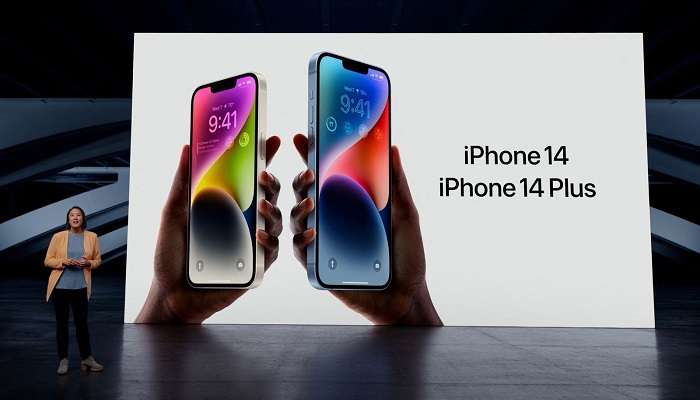
The phones have a larger light sensor, which can produce low-light photographs twice as good as the previous generation’s quality.
The iPhone 14, which was unveiled as Apple’s most advanced smartphone ever, features longer battery life and a variety of camera enhancements.
The new iPhones range from 6.1 to 6.7 inches in length, and feature larger screens than the iPhone 13.
They can last all day on a single charge.
However, one expert noted that Apple had reserved the “biggest leaps” – such as a more powerful processor – for the Pro, its more expensive handset.
The iPhone 14 and 14 Plus come with an upgraded 12 megapixel main camera, which has a brighter flash, wide angle capability, and an action mode for videos that adapts to shaking, motion, and vibrations.
The Pro and Pro Max handsets have a 48 megapixel camera.
The quality of photographs taken in low light is increased twice over what was possible with the previous generation of phone cameras.
More about Apple
“The size of sensors in mobile phones makes taking low-light photos a difficult challenge, according to Ru Bhikha, senior mobiles expert at Uswitch.com,” says the comparison site’s expert.
“The iPhone 13’s improvements, considering the amount of photos we take every day, will sure seem worthwhile compared to the original.”
The standard iPhone 14 uses the A15 bionic chip from its predecessor, but the Pro will be equipped with the faster A16 chip.
Despite the economic challenges facing many consumers, Apple has stuck to its guns and reserved its biggest leaps in innovation for its most premium handsets.
In addition, the Pro versions feature an ‘Always-On Display,’ which means users can view basic notifications without having to unlock the screen.
Apple executive Greg Joswiack said during a virtual event: “It is possible to view time and other key information without having to glance at the screen or press any buttons.”
“All you need is a glance to access critical information on the most advanced display we’ve ever shipped.”
Mr Joswiack said the Pro’s display is incredibly power- efficient because it operates at a refresh rate of only 1Hz.
Apple has discontinued the smallest and most economical iPhone model of previous generations, Mr Bikha said.
The new phones also eliminated the SIM card tray of previous models, allowing users to connect to networks and swap SIM cards digitally.
The iPhone 14 and 14 Plus will include an “Emergency SOS” feature that will allow users to call for help even if they are out of range of a mobile signal.
Apple said a user will be shown where to point their phone to connect to a satellite using the new feature.
An Apple-trained specialist will help them through a questionnaire and subsequent follow-up messages, which can be sent to centres staffed by trained specialists.
“Find My” will also be able to share users’ locations over satellite if they are disconnected from mobile or wi-fi.
Emergency SOS via satellite will be free for two years to users in the US and Canada, and it will be available in November.
There were no details given on when or if the service would be available to users in the UK.
The iPhone 14 will be available for £849 on September 16, while the Plus will go on sale for £949 on October 7.
The Pro and Pro Max go on sale for $1,099 and $1,199 on 16 and 23 September, respectively.
The most rugged and capable Apple Watch yet was also revealed during the virtual event, said COO Jeff Williams.
It is aimed at people who participate in extreme sports, such as deep-sea diving, and is fortified with titanium casing and a sapphire crystal display protector.







